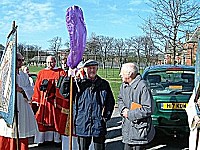
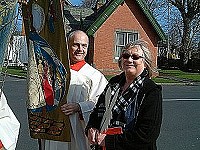
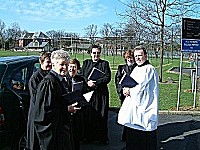
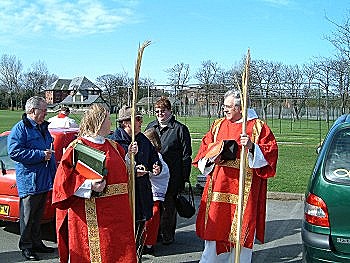
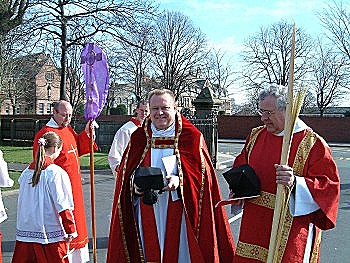
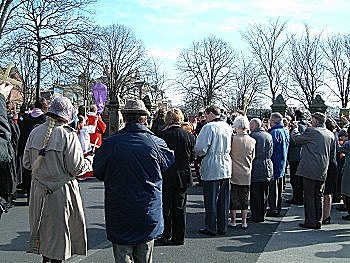
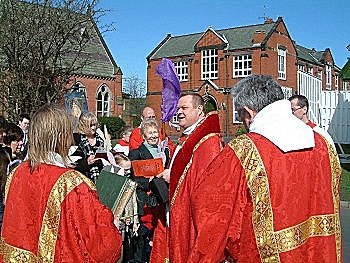
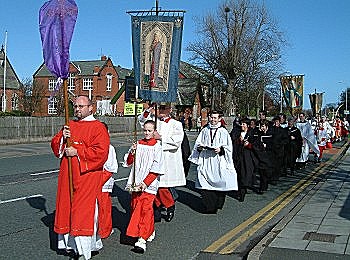
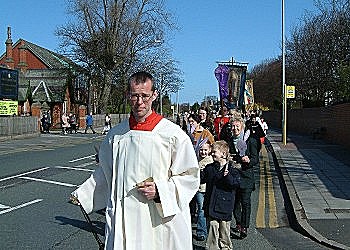

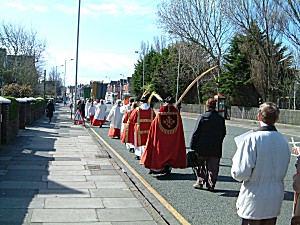
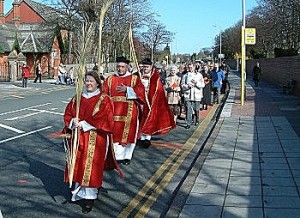
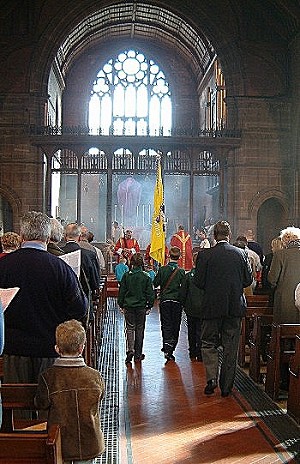
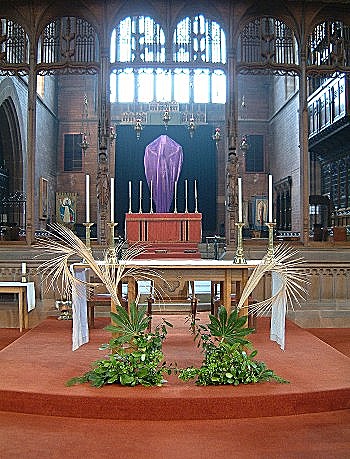





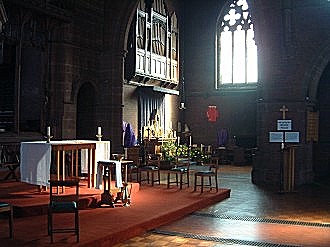
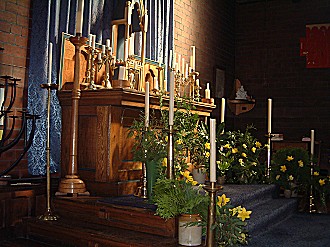
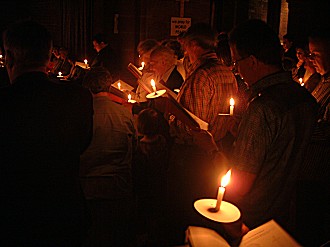
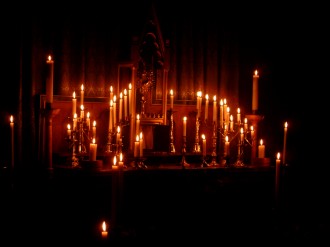
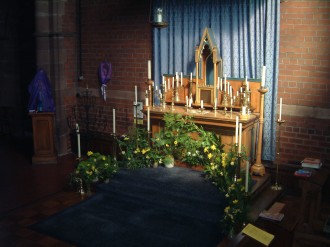
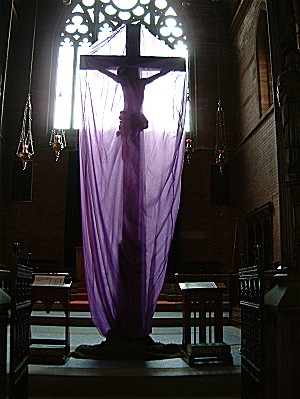
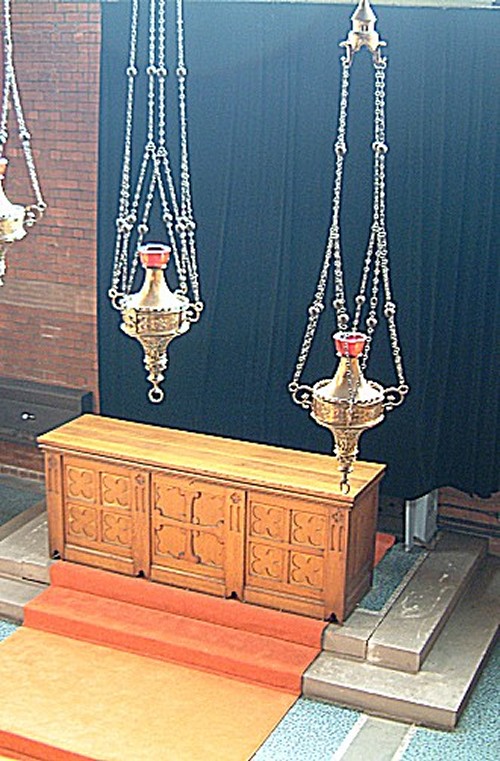
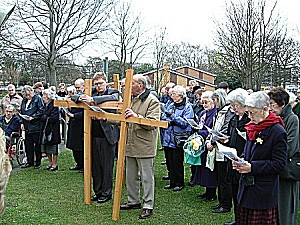
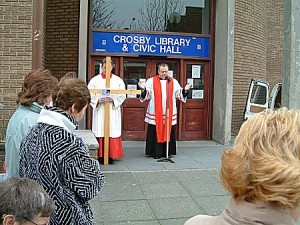
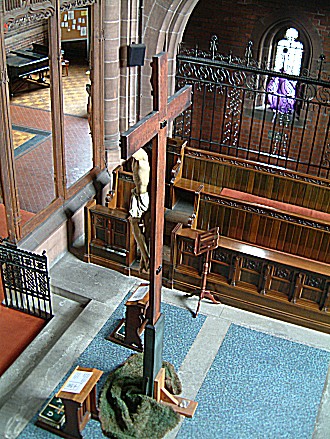
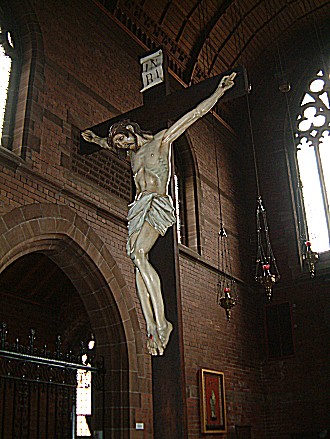
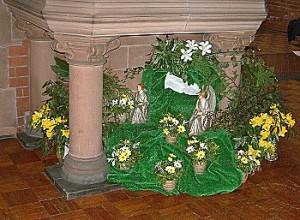


HOLY
WEEK
AND
EASTERTIDE
... what it all means and how and why
we celebrate it
Pictures and words by Chris Price recording the sequence of services and events marking the celebration of Holy Week and Easter at Saint Faith's Church, Great Crosby, in 2004.
Click on any of the pictures in the gallery below for a larger image, and use your browser back arrow to return to the gallery.
 |
 |
 |
 |
 |
 |
 |
 |
 |
 |
 |
 |
 |
 |
 |
 |
 |
 |
 |
 |
 |
 |
 |
 |
 |
 |
 |
 |
 |
 |
|
|
 |
 |
 |
Palm Sunday
Palm Sunday in the Church recalls Christ's entry into Jerusalem, riding the palm-strewn streets on a donkey. It is the the first day of Holy Week, in which Christians seek to follow the Way of the Cross, through the momentous events of Maundy Thursday to Good Friday, the day of Christ's crucifixion, and on to the triumphant resurrection of the first Easter Day. It is a powerful sequence: the most important in the Church's year, and the liturgy and ceremonies that have come to be associated with it are colourful and moving.
As this week unfolded, our pictures show how one church marked Holy Week. The opening images above are of Palm Sunday. For several years now, St Faith's people have gathered in the nearby grounds of Merchant Taylors' School where, after the blessing of our palm crosses and the opening parts of the Palm Sunday liturgy, we process behind crucifer, choir and sacred ministers to the doors of the church. In some recent years we have been able to persuade real donkeys to accompany the walk, but when they are unavailable, as was the case this year, members of the Children's Church lead the way with donkey masks aloft.
Once in church, the Sung Eucharist features a dramatic reading of the long Palm Sunday gospel, with parts for sacred ministers, solo voices and the congregation, as well, this year, as the participation of some of our uniformed organisations bringing up their flags and delivering the prayers.
The Stations of the Cross
The walls and pillars of Saint Faith's are hung with fourteen
striking
red and gold embroidered images of the Stations of the Cross. An
explanation
of the origins of the 'Stations' and photographs of them may be seen by
following the 'Virtual Tour' link from the home page. Every Friday
during
Lent, and finally on the Monday of Holy Week, worshippers at Saint
Faith's
follow the sacred ministers, crucifer and servers as they move around
the
church. At each station, prayers and a meditation are focussed on the
event
pictured, and its relevance to the Christian life today. These four
pictures
show the service in process in the Lady Chapel, the main body of the
church
and finally in the Chapel of the Cross.
Maundy Thursday
The word 'Maundy' comes from the latin 'mandatum', and signifies the 'mandate' of Christ's commandment to his followers at the Last Supper. On the night before He was betrayed to death, Jesus ate supper with his disciples and bade them to eat of the bread he broke for them and drink of the wine he poured for them, and to take these sacramental symbols for all time as His body and blood. This most solemn moment was the institution of the Blessed Sacrament, which down the ages has been the central act of worship of the Christian church, whether known as the Lord's Supper, Holy Communion, the Eucharist or the Mass.
During the Maundy Thursday night Sung Eucharist at St Faith's, as at many other Christian churches throughout the world, we gave thanks for the institution of this most precious gift. As part of the service, eching the actions of Christ at the Last Supper, the presiding priest washed the feet of twelve member of the congregation. The people gathered round the Nave Altar for the Thanksgiving and consecration, and later gathered in the Lady Chapel, which was as always decorated with many flowers and candles for the occasion, representing the Garden of Gethsemane where Jesus was betrayed, members of the congregation kept silent and prayerful Watch until midnight in the Lady Chapel.
Maundy Thursday Watch
Tall arches spanning darkness;
High invisible roof: warm still air.
The shadowed crucifix outlined against carved beams.
And light spilling out through the pillars:
Soft radiance from a firmament of flickering
candles,
Gold and white in the night, swaying shadows.
Burnished sanctuary lamp mirroring the arc of fire
below;
Dark grouped leaves and boughs, and frozen flowers:
Christ on the altar in Gethsemane.
The dull roar of traffic sounds outside the walls.
Silent worshippers kneel or sit to keep their watch,
With only the rustle of a page, the shifting of a
chair
To move the soft silence.
Waiting for death to come to their Lord in the
morning
To bring them life.
Footsteps echo quietly down the dark aisle. The
vigil
Goes on. The faithful watch with Christ.
Outside the cold midnight brings another Good
Friday.
Inside, no time, only the soft shadow of eternity.
Surely, God is here.
Chris Price
(St Faith’s: April, 1973)
Good Friday
Good Friday is the most solemn day of the Christian year. Churches of every denomination throughout the world are united on this day in remembering the suffering and death of Our Lord Jesus Christ on the cross. Not so long ago, Britain came to a halt on this day, with shops closed and the workplace deserted. Today it for most just another day, but the Christian churches continue to give faithful witness to the central event of Holy Week. As well as holding their individual services, the churches of Crosby also come together each year in tribute to their shared heritage of faith. Led by crosses, members of their congregations process to Crosby Civic Hall for a joint outdoor service of witness at 11.00 am, presided over in turn by one of the clergy of the participating Anglican, Nonconformist and Roman Catholic Churches. Two of our pictures show some of those who took part in this year's service, which was taken by Fr Neil Kelley.
The remaining images for Good Friday are of St Faith's. During Holy Week, the Great Crucifix, together with the other images in the church, is veiled. For Good Friday it is brought down from its Lenten position above the High Altar to be placed immediately above the chancel steps at the entrance to the choir, leaving the stripped High Altar and the hangings concealing the folded-in reredos open to view for this one time in the year. Now unveiled, the crucifix was the powerful and dramatic focus of the Liturgy of Good Friday, which concluded at 3.00 pm, traditionally the hour at which Christ died on the cross. Towards the end of the service, members of the congregation were invited to come forward and pray at the foot of the cross.
Holy Saturday and Easter
The day following Good Friday, wrongly known as Easter Saturday (which is really the Saturday after Easter Sunday) is properly called Holy Saturday, or Easter Eve. It is a time of expectation and waiting, as the Church looks forward eagerly to the resurrection of Christ; it is also a time of preparation as church communities everywhere prepare for Easter, making buildings ready, decorating them with flowers, and decking them out in readiness for the Queen of Festivals.
At St Faith's, as at many churches of similar tradition, the evening was marked by a very special service, the Easter Vigil and first communion of Easter. This colourful and moving ceremony began outside the darkened church, with the symbolic kindling of the New Fire. Following this, the congregation moved into the church, and the light was spread from person to person until the building was full of candle-light. The story of the events prefiguring and leading up to Easter was told, from the Old to the New Testament, culminating in an explosion of light, bells and noises of every kind as the service moved into rejoicing at the impending resurrection of Christ. All present renewed their baptismal vows - and for 2004 three children received their actual baptism, before the Sung Eucharist was celebrated with joyf ul words and music.
Following the service, in a tradition established in recent years at Saint Faith's, champagne was served, Easter Biscuits were eaten, and fireworks were let off (these latter in the vicarage garden!). The solemn devotions of Holy Week were at an end, and Easter Sunday itself was waiting to dawn.
Easter Day itself saw the final services of this busiest of weeks. The 11.00 am Easter High Mass was accompanied by a trumpeter and finished with the serving of wine to the congregation in church. The evening saw Festal Evensong celebrated with more music and processing, before some 115 parishioners and friends adjourned to the parish hall for the now traditional Easter party. A lavish array of hot and cold food was served, and to round things off parishioners old and young offered a free and easy programme of musical turns to the delight of one and all.
For the Church, Easter Day is very definitely a beginning and not an
ending. The glorious resurrection of Christ continues to be celebrated
throughout the days and weeks after Easter, and got off to a flying
start
on Easter Monday with a noon Sung Eucharist and champagne in the
vicarage.
Fr Neil Kelley's Easter Day
Sermon 2004
Like many other people I went the other week to see the film that cost some 15 million dollars to make – the Passion of The Christ. I crept out of my retreat at Mirfield and took the bus to Wakefield to see it believing that watching that film was as good as reading any book on the subject of the Crucifixion. It’s always difficult knowing what to expect when so many people, and so many films critics, have given their verdict. One of the criticisms which has been voiced is that it paints the Jewish people in a bad light. It apportions blame; it’s anti-Semitic. The spurning of Jews by Christians for many centuries is a scandal and a tragedy. It is a warning of how a religion whose core ethic of love and forgiveness can harbour and justify prejudice and hatred. Many of us could win Oscars for a portrayal of Jekyll and Hide – Hosanna; Crucify….
As I watched the film, and the two hours flew by, I didn’t find
myself
sitting there and thinking “is this what they did to Him?” I wasn’t
compelled
to think about what others did to Jesus, I felt myself thinking again,
and again, “is this what we do to Jesus?” The portrayal is gory,
is bloody, is at times painful to watch, perhaps some of the violence
is
over the top; however, there’s one thing I’m certain about and that is
if Jesus was condemned to death, forced to carry his cross and nailed
to
it then it couldn’t have happened any other way. No general
anaesthetic,
no heavy strength ‘Nurofen’ the pain of nails through the skin and onto
the wood must have been horrific. Is this what we do to him each time
we
sin?
In order to answer that question we have to first have a concept of
sin. Our sins either wound and pierce the heart of God or he
isn’t
bothered by our behaviour and if that is the case why are we bothering
to be here today? Its not trendy and “in” to talk about sin in
the
church today. The great liberals who have the hot-line to God tell us
we
should talk about “alienation” rather than sin. If it makes you feel a
little easier then talk about what you like. The fact remains we cant
re-invent
a notion of sin to fit our convenient DIY theologies. As long as the
Church
continues to include Good Friday and Easter Day in her calendar we are
most definitely dealing with issues of sin and death, forgiveness and
new
life.
You might say why talk about the Crucifixion today? Well firstly, only
a fraction of you came to church on Good Friday, and secondly, we
cannot
fully appreciate what today is about unless we have fully grasped the
reality
of Our Lord’s suffering and death. In his book entitled “Good Friday”
the
Methodist writer Neville Ward says “unless we change we cannot grow”.
Easter Day is about change and growth though many of us know how difficult that can be. We are prone to cling to favourite sins: gossip, bitching and criticism, though highly destructive, can often fill parts of our lives that are otherwise empty and meaningless. So much of what we would term our “sins” come as a result of failing to love ourselves, to respect ourselves and indeed looking for love in all the wrong places. So many of our favourite sins have become an integral part of our existence. Without them it would be like suffering a bereavement; an emptiness. The first disciples had to face those feelings of emptiness and bereavement before Our Lord appeared to them in his Risen Body. There are things in each one of us which need to die if we are to have the capacity to live as God’s Easter people.
You see there is one thing we all have in common concerning the way we were divinely made: we each have a hole in our heart, a gap which needs filling. And although each one of us is a different shape and size, for each of us have that hole is the same shape. God shaped. And when the hole is filled, we become whole.
Trying to reflect God’s love is not an easy option. But is that not the point of Our Lord’s agony in the garden? – that realisation that God’s will and purpose for Him couldn’t be ignored, there was in fact only one path…. As someone once said: "Love is like heaven, but it can hurt like hell."
Hell on earth is a reality for many, many people. There are occasions in life that are so crushingly evil. There are extremes of cruelty that are just not acceptable. There are times of such sadness that they literally break your heart. There are places we just should not have to be. But miracles occur in hell. Easter speaks of the miracle of growth and new life even in the face of so much evil and hatred.
From whatever perspective we look at the cross, in human history or our own individual journey through life, the cross stands at the crossroads on the same old road – our old way of life – or we can opt for moving in a new for each of us. We may choose between keeping direction. The marvellous thing about God’s love is that there are no conditions attached. We can choose to accept his love, or we can reject it. The choice is in our hands. We can take up our cross or we can pass by on the other side. We can speak out or we can remain silent. Our words and our actions can match up or they can be at odds with each other.
On September 11th 2001 a new Calvary came into existence. Millions of New Yorkers were beginning their working day. By the end of that day Manhattan was covered in ash. Millions watched the scenes as they were televised and re-televised. Newspapers carried photographs of bodies falling from the towers. Heartbreaking innocence as children clutched the hands of their parents on board the planes as they struck the towers. People desperately calling cell phones to tell loved ones “I love you” for the last time. There was horror and there was profound love mixed into one. The immediate fear of death brought the reality of love and life out into the open.
If we were to find out that in ten minutes time a bomb would fall on this church how would we use those last moments? Would there be a queue of people wanting to make their confession, to be reconciled with God? Would you be desperately grabbing a mobile phone, anxious to call the family member or friend you haven’t spoken to for months or years and tell them you are sorry – that you really do love them after all even though you wont see them again? Why does it take something unspeakably awful and tragic for us to realise the love we have in God and in each other? Can we only respond to love when it seems time is running out?
On the Cross Jesus said “I Thirst”. In the last letter of her life Mother Teresa wrote “Let our gratitude be our strong resolution to quench the Thirst of Jesus by lives of real charity – love for Jesus in prayer, love for Jesus in our sisters [and brothers], love for Jesus in the poorest of the poor – nothing else”. Easter Day challenges us to rethink our priorities. Have we got them right? Some of the tabloid newspapers carried the most important story in the world on seven whole pages in the last week or so. I mean the alleged affair of David Beckham and his P.A. It must be one of the most important pieces of news in the 21st Century as some of the tabloid newspapers gave it far more coverage than they did the war in Iraq. We can’t however blame the papers for getting things out of proportion; they do so because we buy them. And we buy them because we have a perverted fascination with reading about the downfall and intimate details of other people’s private lives. So often we’d rather have a bit of scandal than something that really mattered. Who cares if David Beckham plays away or scores at home?
But like the question of who was/is responsible for the Crucifixion of Jesus we can criticise the newspapers for their obsession with sleaze and fail to ask ourselves ‘have we got our priorities right?’ Have we got them right at home, in our personal lives, in the life of our church? Take Passion Sunday and Good Friday 2000 for example. On Passion Sunday, the parish AGM, and a vote for the first time in the history of Saint Faith’s for the office of Churchwarden. 91 people turned up. A week or so later on Good Friday, the day when we remember how God saved the world, 54 people came to church. Is that an example of getting our priorities right?
We live in a world, we live in a community, in which people are desperately hungry for good news. On September 11 2001 more than twice as many people on earth died of AIDS than in the tragedy at the World Trade Centre. On each day in 2001 an average of 8,219 people died of AIDS. In the last 45 years suicide rates have increased by 60 percent worldwide. Suicide is now among the three leading causes of death among men and women aged 15-44, and for each suicide there are 20 attempted suicides. In the UK and Ireland there is one suicide every 79 minutes. Loneliness, depression, stress, crime, discrimination and mental illness affect even the materially well off.
Do we need Good News? You bet we do. We have to believe that we can make a difference. Someone once said that if all the people who called themselves Christian actually lived out their faith, there would be no poverty in the world. Actions are needed if the Easter faith is to be proclaimed. That will sometimes be difficult and our lives will need to be changed over and over again. Unless we change we cannot grow. Christians are often attacked by politicians for too getting involved in politics. People are happy for the Church to get involved in the world so long as we don’t rock the boat. An saying of Archbishop Helder Camara who served the peoples of Latin America is often quoted: “When I feed the poor, they call me a saint; when I ask why they are poor, they call me a communist”. If we take our Christian calling seriously, we will want to challenge injustice and discrimination in society; we will want to feed not just spiritual hunger but those who are quite literally starving though lack of food or the basic things we take so much for granted. But unless we change we cannot grow. And unless we grow, in the love of God, we cannot witness to Him effectively.
These are difficult times for the Church. A decrease in church membership nationally, and yet a new type of interest in spirituality, often seen when the nation mourns a tragedy. Candles and flowers placed on street corners and other Calvary’s where people have died tragic deaths. A need to be met. A thirst. A hunger. And the church is not always meeting people where they are. Certainly as an established Church, the Church of England has lived for many years upon its memories of times past. It is now high time we woke up and looked about us, grasped reality and faced the future. We either read the signs of the times or bury our head in the sand. Is that not the Easter message? Perhaps the lack of clergy and the lack of money in the church will one day help us to focus our thoughts, prayers and efforts in a new way? Maybe it is time for us in the church to reassess our priories? A bit like moving from a large house to a small flat – some things have got to go. Unless we change we cannot grow.
The family of Saint Faith’s has a good history of rising to challenges. And many people will testify to the love, care and compassion which is so freely offered when it has been most needed: at times of crisis, a diagnosis of cancer, a bereavement, helping to put a life back together after a prison sentence, support for people with depression, visits to hospitals, nursing homes and hospices. A helping hand, a lift here, shopping done there. When we want to we can do all of this and much more.
In that plane heading for the World Trade Centre people faced reality and love emerged. It shouldn’t take a disaster for us to realise how much we are loved and how much we are called to love others. The disaster of disasters upon the hill of Calvary 2000 years ago was turned into a triumph of God’s power and His love. Amid the pain, the blood and the sweat of carrying the cross Our Lord said “see, I am making all things new”. Unless we change we cannot grow.
As we celebrate the Resurrection of Our Lord and Saviour Jesus Christ today, make a resolve to get your priorities right and live life to the full today and every day. Be reconciled today and every day. Accept God’s power to change your life today.
Today He is Risen. Today He calls us to go out and proclaim that
Good
News. Today He needs you and me to do His work in His world.
Some Prayers for use at
Easter
Christ has no body now on earth but yours,
no hands but yours,
no feet but yours,
Yours are the eyes
through which is to look out
Christ's compassion to the world;
Yours are the feet
with which he is to go about
doing good;
Yours are the hands
with which he is to bless men now.
Lord of all life and power, who through the mighty resurrection of
your Son overcame the old order of sin and death to make all things new
in him: grant that we, being dead to sin and alive to you in Jesus
Christ,
may reign with him in glory; to whom with you and the Holy Spirit be
praise
and honour, glory and might, now and in all eternity. Amen
A Sequence for Holy Week
Palm Sunday: a journey undertaken.
Strung out behind cross and choir,
Two hundred straggle from the secular to the sacred
As the incurious cars stream past,
Seeking a different consummation.
Safely within the waiting church
They reform in more purposeful procession,
Parading palms, chanting almost in time,
In hopeful pilgrimage to the Holy City.
And now the Passion is acted out -
Readers in solemn counterpoint,
The practised crowd jeering in unison.
A sombre, waiting stillness takes the place
Of a confusion of circling movement.
The first act and the first action are done.
Monday in Holy Week: a different journey.
The woven stations of the cross
Red and gold against pillars and brick walls
Each in turn a focus of shuffling movement
For those who come in from the darkness.
In the lowered light the story unfolds
From condemnation to crucifixion,
Clustering round each resting place
While women’s voices, light and softly-pitched,
Charged with a mother's empathy for a Son,
Underscore the unyielding way of the cross.
It ends in a quiet consecration.
The calm offering of the Eucharist
Draws all movement into its timeless pattern.
The second act and its action are finished.
Maundy Thursday: the shortest journey.
From pew and choirstall but a few steps
To the altar where things broken are renewed
And the ultimate mystery is made manifest.
Standing in solemn expectancy
At the point where the moving images are stilled,
Witnesses to a sacrifice renewed,
Young and old come together in commemoration
Of a life laid down for the earth's remaking:
To share in the circling host.
Then, in the cool, watching darkness,
Flanked by unwavering candleflame,
Christ rests again as in the tomb:
The axis of the turning of the world.
The third act rests from its pivotal action.
Good Friday: the longest journey.
First, the witnessing.
Behind a wooden cross, through the everyday streets
To sing slow choruses to the inevitable ecumenical guitars:
The sound frail and uncertain,
Drowned by the traffic’s ceaseless rumble,
As nothing to those who pass by.
Later, the patterned worship of the liturgy within:
The altars stripped bare and waiting.
Lifted by the choir’s soft, hidden anthems,
A veneration profound, silent and slow is offered
Beneath the great carved crucifix -
Christ suspended between earth and heaven -
Shadowed against the black hangings.
The fourth act is over: its action rests in the grave.
Easter Eve: a journey out of darkness.
The new fire kindled in the blackness;
Continents of light spreading outwards and upwards.
The rising cadences of proclamation;
The ancient stories of the listening vigil
Spaced with the silences of the final waiting.
And then suddenly the dazzling sunburst:
The trumpeted glory of the certain resurrection -
Golden and white, fully-flowered in light;
The wreathed ascending clouds of the holy smoke;
The high, impossible hymns of joy.
In the far sanctuary, bishop and priests
Celebrate again the paschal sacrifice
In triumphant prelude to the splendours of the Easter dawning.
The last act rests now in is final action.
And this is its beginning.
Chris Price
(This poem, written in 1991, reflects, as does the poem 'Maundy
Thursday Watch' above, the pattern of worship at Saint Faith's at that
time. Some details of liturgy and practice have inevitably changed and
developed over the years.)
The clergy and people of Saint
Faith's, Great Crosby, wish all our readers a very happy and blessed
Eastertide.